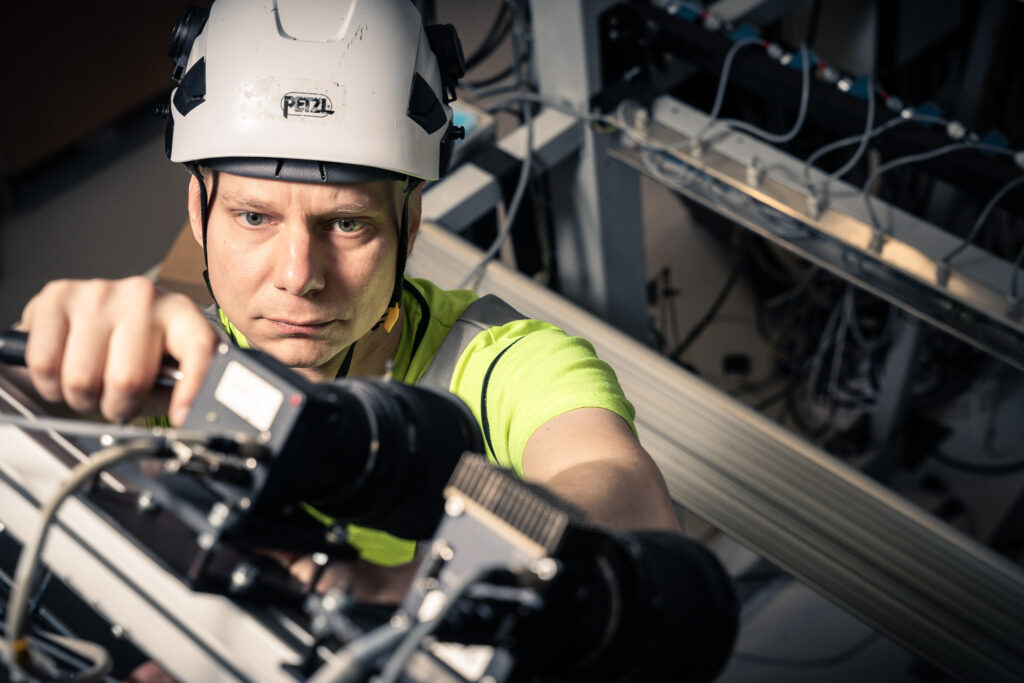Sawmill maintenance is a comprehensive process where mechanical, electrical, and automation system upkeep go hand in hand. Each part directly affects production smoothness and yield. At Lisker, predictive maintenance means both annual checks of measurement and optimization equipment during downtimes and continuous readiness to support the customer in daily operations.
“In practice, this means we inspect the equipment and respond to anomalies before anything can disrupt production,” describes maintenance expert Matias Ala-Hemmilä from Lisker.
During maintenance, cameras, lasers, and photoelectric sensors are cleaned, mounts are checked, the condition of optics and sensors is ensured, and gauges are calibrated.
Additionally, the customer can contact us at any time for advice – often a quick remote check is sufficient to prevent a larger issue.

Lisker’s maintenance expert Matias Ala-Hemmilä.
Small Adjustments, Big Impacts
The sawmill environment is demanding: vibration, temperature fluctuations, dust, and mechanical impacts strain the measuring devices daily. Although the equipment is designed to withstand these conditions, natural adjustment needs arise over time – for example, a camera or light mount may loosen, optics may become dirty, or a log impact may slightly displace the camera.
These changes are often unnoticed but over time affect measurement accuracy and thus yield.
“If the gauges are kept in good condition, it will show in the yield – maybe not immediately, but certainly in the long term,” Matias notes.
For example, if a sawmill processes 400,000 m³ of wood annually, even a half-percent deviation in yield means about 1,000 cubic meters less finished product per year – an impact that can be worth several hundred thousand euros.
At many sawmills, small deviations are accepted as part of daily operations. If a gauge works “somehow,” production is not stopped – and it is often thought that the issue will be resolved in the next downtime.
Matias encourages reaching out with a low threshold: “A maintenance visit is not always needed – often a remote investigation of logs, error messages, or usage instructions is enough to prevent a major fault.”
However, if the remote investigation shows that the situation requires a physical inspection, maintenance is dispatched immediately – often on the same day.
Maintenance is an Investment in Production
Predictive maintenance is more than just fixing faults – it is continuous collaboration and part of the sawmill’s daily operations. At many sawmills, predictive maintenance is performed regularly every four months – either remotely or on-site. All maintenance is reported to the sawmill’s contact persons, creating a clear continuity and written history that facilitates monitoring and analysis of situations later.
During maintenance visits, practical tips are shared: how to clean cameras, what to check during calibration, and how to notice when a device needs attention. At the same time, updates to older gauges are planned before component availability becomes an issue as technology advances.
When the sawmill’s own staff also knows the measuring devices and can perform basic maintenance, potential deviations are detected earlier.
“If someone at the sawmill is interested in learning, we are happy to show how to diagnose the gauge themselves. It speeds everything up,” Matias explains.
At Lisker, maintenance is offered as a service tailored to the needs of each sawline. The goal is the same as at the sawmill: to ensure that the equipment operates accurately and that the best possible value is obtained from each log year after year. It is an investment that pays off in fewer downtimes, more consistent production, and better yield.


